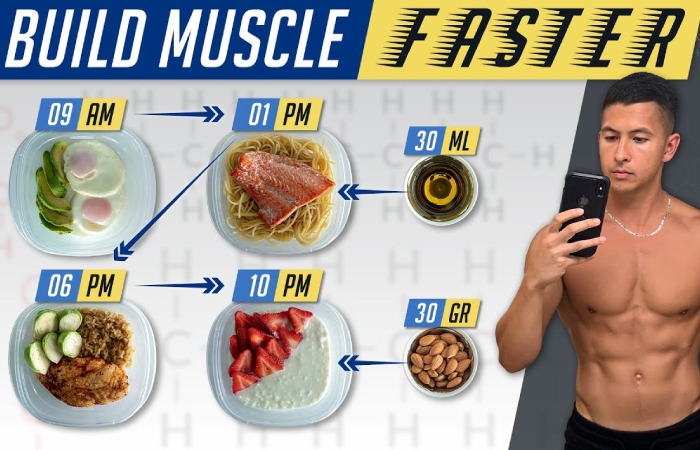Table of Contents
Introduction
wellhealthorganic.com/how to build muscle know tips to increase muscles: Muscle building often comes first when it comes to physique enhancement. The added muscle mass improves your muscle definition, improves your lean body mass, and increases size in all the right places.
Building muscle takes time, persistence, and a long-term commitment. While building large amounts of muscle mass may seem daunting, most people can gain significant muscle with the right exercise programs and proper consumption of certain foods.
This article summarizes everything you need to know about building muscle, including how to train, what to eat, and recovery protocols.
The Benefits Of Wellhealthorganic.com/how to build muscle know tips to increase muscles

Building and maintaining muscle is essential to a healthy, active lifestyle. It’s not just for young athletes or fitness enthusiasts.
Doctors agree that it’s a good idea for everyone to incorporate strength training into their daily routines.
With age, muscle mass and muscle cross-sectional area can decrease (sarcopenia), resulting in reduced bone density (osteopenia), reduced strength, and ultimately reduced function.
Maintaining strong muscles contributes to strong bones, which can prevent fractures and degenerative diseases such as osteoporosis.
According to the Journal of Health & Fitness, loss of muscle mass can lead to a “cascade of health problems” including bone loss, fat gain, diabetes, heart disease, and mortality.
In addition to improving blood pressure, glycemic control, and lipid (cholesterol) profiles, strength training to build muscle can improve mental health.
Fundamentals Of Muscle Development

Physiologically, skeletal muscle is a series of parallel cylindrical fibers that contract to generate force. This muscular contraction allows all external human movements.
Your body is constantly renewing and recycling the amino acids or building blocks of protein, in your muscles.
When your body removes more protein than it adds, you lose muscle. When net protein synthesis is constant, there are no measurable changes in muscle size. Eventually, if your body stores more protein than it removes then your muscles will grow big.
The key to build muscle is to increase the protein synthesis rate while decreasing the protein breakdown rate.
Increasing muscle mass is called muscle hypertrophy and is the primary goal of resistance training.
The muscle-building process is stimulated by a number of factors, including hormones such as testosterone and growth hormone, as well as the availability of amino acids and other nutrients.
To build new muscle tissue, your main tool for increasing your body’s rate of protein synthesis is to do resistance training and consume adequate amounts of total protein and nutrients.
The right amount of resistance training will activate your body’s hormonal response to build muscle, but it also requires the availability of sufficient protein and energy to ensure that the process results in muscle growth and not muscle loss.
As researchers and experts continue to study the science of optimizing muscle growth, moderate to heavy resistance training combined with a relatively high protein intake is the only proven training method to increase muscle mass.
Wellhealthorganic How to Build Muscle Tips
While many types of exercise offer better health benefits, the only way to reliably promote muscle growth is to train your muscles against moderate to intense resistance. Furthermore, muscle growth is specific to the muscles used.
1. Choose The Right Weight

In all cases, the weight should be so heavy that doing more than 20 repetitions is impossible.
Your weight should leave you at or near failure for the specified number of repetitions.
For example, if you do a set of 10 reps, by the 10th rep you should be unable or nearly unable to do another rep. If your goal is to build your muscle, you should rarely exceed “two reps in the tank” at the end of the set.
The general implication of the rep range continuum is that you should go through different phases of training with different rep ranges to see what gives body the most muscle growth.
2. Choose Your Exercises Well

As mentioned above, muscle development is specific to muscle work.
For example, you need to do exercises that work the biceps to build bigger biceps. This can be an isolated biceps exercise, like B. a bicep curl, or a compound movement that uses the biceps like pull-up.
When it comes to the best types of exercise for building muscle, compound and isolation exercises can be just as effective for creating muscle hypertrophy.
Still, for the best long-term fitness results, incorporate compound and isolation exercises into your workout.
Compound movements, such as barbell squats, effectively target multiple major muscle groups in a single exercise, providing a more functional movement for real-life activities. This results in more efficient training and more practical muscle power.
Isolation movements are a great way to work specific muscles, and beginners may initially find them safer and easier to learn than compound movements.
Also, it’s easier to do isolation exercises when you’re tired because you’re not immobilizing your entire body.
Therefore, this can give you a few more focused sets at the end of a workout when you’d otherwise be too tired to do another compound exercise.
3. Structure Your Training To Avoid Overtraining

A better rule of thumb is to do 3 sets of 3-5 compound exercises per workout, followed by 3 sets of 1-2 isolation exercises.
Typically, you do your heaviest sets with compound movements and high reps on your isolation exercises.
Assuming you’re doing three working sets per exercise.
Limit your total joint work involving compound and isolation movements to 5-7 movements per workout.
Also, it allows you to get the most out of any type of exercise.
Maximizing the full muscle building potential of your training program and avoiding all the symptoms of overtraining.
How To Eat To Build Muscle

To build muscle, you need to get the right amount of calories and nutrients, especially protein, into your body. This helps build new muscle protein from the dietary protein you eat, fueled by your work in the weight room.
Your body has a maximum rate of muscle development and above this limit, excess calories are stored as fat. If your goal is lean muscle mass, you should avoid gaining a lot of body fat.
Calories are necessary to build muscle.
For lasting muscle growth without excess fat, you should consume 300 to 500 calories more than your basic daily requirement.
Protein is essential for building muscle.
When it comes to muscle-building nutrients, protein comes first. Recent research suggests that those exercising to build muscle should consume about 0.72 grams of protein per poundof body weight per day.
Conclusion
It’s possible to build muscle with any rep range, and some people may respond better to low or high reps with heavy or light weights, respectively.
A muscle-building diet requires adequate protein and calories to fuel growth. Avoid consuming more than 300 to 500 extra calories per day to reduce body fat. wellhealthorganic.com/how to build muscle know tips to increase muscles. Building muscle mass takes time and is limited to 0.5 to 0.9 kg per month.

